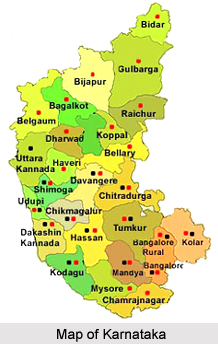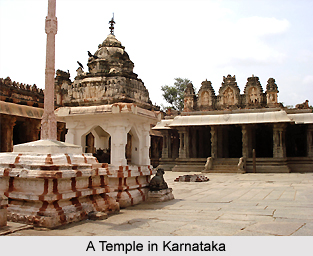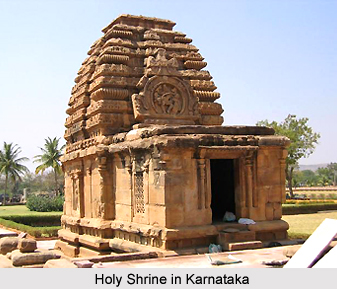 Karnataka has a costal line with natural beauty, hedged by miles and miles of tall, waving, palm groves adds to the natural beauty of the place. It has an area of 74051 sq mi. The capital of Karnataka is Benagluru, which is undoubtedly the trump card of the state. Benagluru is known by many names as the Garden City of India, India"s Manhattan and Silicon Valley. It is one of the most industrialised cities of the country; its pleasant climate makes it the seat of much commercial and cultural enterprise. The important tourist sites are Garden city Bengaluru, Jog Falls, Karwar beach and Malpe beach, Golgumbuz in Bijapur, the stone temples of Belur and Halebid, Mysore Palace, the list is endless. Karnataka is actually the key to discover the enthralling beauty of nature.
Karnataka has a costal line with natural beauty, hedged by miles and miles of tall, waving, palm groves adds to the natural beauty of the place. It has an area of 74051 sq mi. The capital of Karnataka is Benagluru, which is undoubtedly the trump card of the state. Benagluru is known by many names as the Garden City of India, India"s Manhattan and Silicon Valley. It is one of the most industrialised cities of the country; its pleasant climate makes it the seat of much commercial and cultural enterprise. The important tourist sites are Garden city Bengaluru, Jog Falls, Karwar beach and Malpe beach, Golgumbuz in Bijapur, the stone temples of Belur and Halebid, Mysore Palace, the list is endless. Karnataka is actually the key to discover the enthralling beauty of nature.
The name Karnataka comes from the words of the Kannada Language `Karu` and `Nadu` meaning elevated land. Karu Nadu can also be read as Karu, which means black, and Nadu, which means region, which may be with reference to the black cotton soil found in the Bayaluseemae region of Karnataka. Karnataka, the Indian state, was named in the year 1973.
History of Karnataka
The history of Karnataka is very rich and has been ruled successively by the Buddhist, Hindu and Muslim dynasties. Jainism too, established its roots here. During the first millennium AD, the whole of Karnataka was dominated by power struggles between the various kingdoms that controlled Western Deccan Plateau. In the Medieval era, the Muslim invasions from the North forced the fractured states of the south into close alliance with the Vijanagars, who emerged as the land lords. In 1761, the Muslim campaigner Halider Ali, with French support, seized the throne. His son, Tipu Sultan, turned Mysore into a major force in the south before the British killed him in 1799, at the battle of Srirangapatanam. In 1830, the British appointed a Commission to rule in their place. After which the state was ruled successively by the Janata Dal, BJP and Indian National Congress Governments.
 Geography of Karnataka
Geography of Karnataka
Karnataka is situated on the western edge of the Deccan plateau and is surrounded on the North by Maharashtra and Goa, on the East by Andhra Pradesh, on the South by Tamil Nadu and Kerala and on the West, it opens out on the Arabian Sea. Karnataka occupies three natural regions like the Coastal strip, the Sahyadris Mountain Range and the Deccan plateau and lies between 74 degree and 80 minutes East longitudes, and 11 degree and 18 minutes North latitudes. The elevation of Karnataka is 1,500 feet. The highest temperature recorded here was 45.6 C and the lowest recorded temperature was 2.8 C (37.04 F). Karnataka receives an average annual rainfall of 1139 mm. The highest point in Karnataka is the top of the hill Mullayanagiri, which has an altitude of 1929 m above sea level. There are 27 districts of Karnataka state that are grouped into four divisions. The four divisions are Bengaluru division, Belgaum Division, Gulbarga Division and Mysore Division.
Demography of Karnataka
As per details from Census 2011, Karnataka has a population of 6.11 crore. The total population of Karnataka as per 2011 census is 61,130,704 of which male and female are 31,057,742 and 30,072,962 respectively. In 2001, total population was 52,850,562 in which males were 26,898,918 while females were 25,951,644. The total population growth in this decade was 15.67 percent while in previous decade it was 17.25 percent. The population of Karnataka forms 5.05 percent of India in 2011. The literacy rate in Karnataka has seen upward trend and is 75.60 percent as per 2011 population census. Of that, male literacy stands at 82.85 percent while female literacy is at 68.13 percent. In actual numbers, total literates in Karnataka stands at 41,029,323 of which males were 22,808,468 and females were 18,220,855.
Culture of Karnataka
Karnataka is a treasure island of ritualistic dances. The dances are denoted by the generic term Kunitha. The major art forms are Dollu Kunitha, Puja kunitha, Pata Kunitha, Gorava Kunitha, Kamsale, Devare Thatte Kunitha, Yellammana Kunitha, Suggi Kunitha. Other than these dances, Bharatnatyam, Kuchipudi and Kathak are well known classical dances. The music of Karnataka flourished under the royal patronage of the Vijayanagar Empire and the Wadayars. The Hindustani music and Caranatic music are the popular music genres of Karnataka. Yakshagana is an elaborate dance-drama performance unique to Karnataka. Major festivals of Karnataka are Dussehra, Hampi Festival, Tula Sankramana Coorg Festival, Vairamudi Festival, Kambala or buffalo racing, Sri Vithappa fair, Sri Shidlingappa`s fair etc. The Mahamastakabhisheka festival also attracts numerous pilgrims to Karnataka.
 Education in Karnataka
Education in Karnataka
Karnataka has the highest number of educational institutions in the fields of engineering and medical sciences. The major educational institutions comprise of Indian Institute of Science and Indian Institute of Management. Some of the institutions that are involved in undergraduate engineering education are National Institute of Technology, Visvesvaraya Technological University, M. S. Ramaiah Institute of Technology.
Administration of Karnataka
.
Governor is the constitutional head of the Karnataka and is appointed for a period of five years and he appoints the Chief Minister. The governor is only the ceremonial head of the state. The day to day running if the government is taken care of by the Chief Minister and his council of ministers. The State legislature consists of the Legislative Assembly and the Legislative Council. The Commissioner of Police is entrusted with the responsibility of maintaining law and order in the state. The district head of each development department such as PWD, Health, Education, Agriculture, Animal husbandry, etc, look after sectoral development. At the national level, Karnataka consists of 28 parliamentary constituencies from which 28 members of parliament get elected to the Lok Sabha. Karnataka is dominated by three major parties. They are Indian National Congress , Janata Dal (Secular), Bharatiya Janata Party (BJP).
Economy of Karnataka
Karnataka has become one of the leading industrial states in the field of industrial development. It has established its roots both in the private and public sectors and in the area of computer software. There are the presence of a number of traditional cottage and small industries like handlooms, silk weaving etc. Karnataka is the leading state for silk rearing and production of Khadi and village industries. There are numerous factories in engineering, chemicals, electrical, and electronic goods. There are also industries for processing of plantation products like tea, coffee, rubber, cashew etc. About 71% of the people are engaged in agriculture. The main crops are rice, ragi, jowar, maize, and pulses besides oilseeds and number of cash crops. The principal crop grown here is coffee. Cashew, coconut, areca nut, cardamom, chillies, cotton, sugarcane and tobacco are among the other crops.
Tourism of Karnataka
There are a number of natural and man-made tourist locations in the state of Karnataka, as it is blessed with diverse topography and history and boasts a wide range of advanced cities, scenic locations and ancient temples. The most renowned locations are Agumbe Hill Station, Madikeri, Kudremukh, Nagarhole National Park and Bannerghatta National Park, also the ruins in the at Hampi of the Vijayanagara Empire and Monuments of Pattadakal. The rock-cut cave temples of Badami at Aihole and the temples of Halebid and Belur are also among the most visited sites. The popular waterfalls include the Gokak Falls, Jog Falls, Magod Falls, Shivanasamudra Falls and many more. Moreover, there are also numerous famous beaches like Gokarna, Murudeshwara and Karwar.






